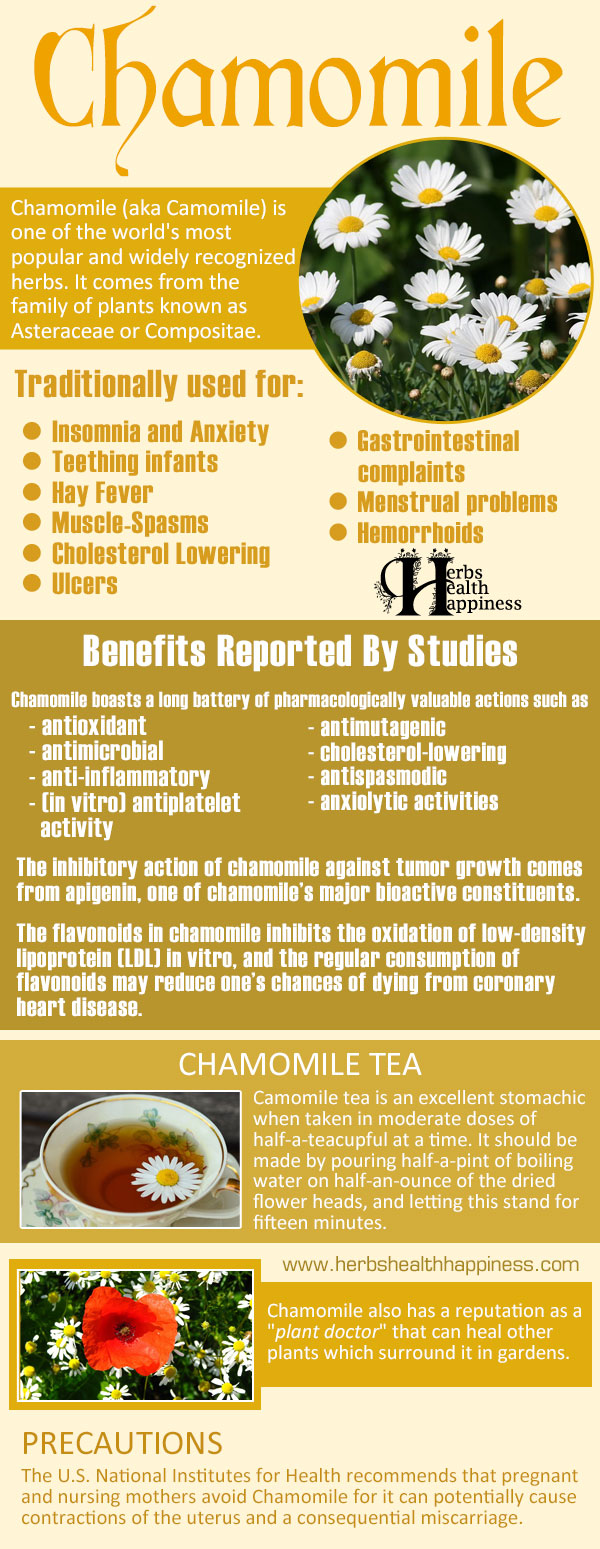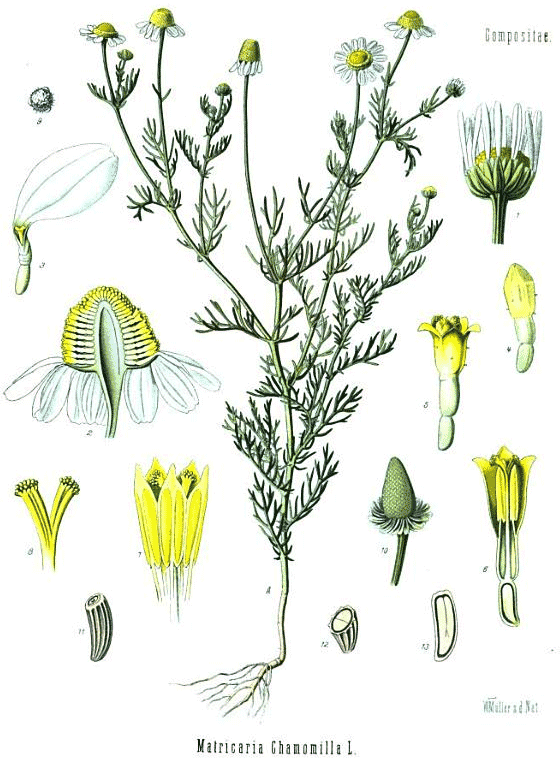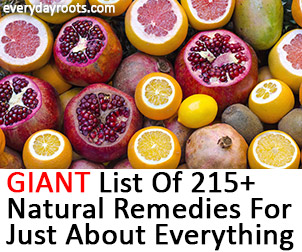Chamomile

Uses Of Chamomile - image to repin / share
Graphic - herbshealthhappiness.com. Image sources - see foot of article.

Chamomile - Botany And History
Chamomile (aka Camomile) is one of the world's most popular and widely recognized herbs. It comes from the family of plants known as Asteraceae or Compositae. The part of the plant typically used in herbalism are the flowers, which are sweetly aromatic and have a bright yellow center with white radiating petals closely resembling those of a daisy.
Originally, the word, Chamomile, was derived from the Greek, chamaimilon, or "earth apple." In Russia, Chamomile is the national flower. [1][2] There are several species of Chamomile including German or Roman and others, which are unrelated botanically speaking, yet both contain a blue-colored oil containing the plant's active constituents. [3] The plant is used mostly in herbal teas, medicine, perfume and condiments. It is indigenous to Europe and western Asia. [4] The FDA includes Chamomile in its (GRAS) list, or Generally Recognized As Safe. [5]
In English herbalist Culpeper's famous 17th century Compleat Herbal, he states, "It is so well known everywhere that it is but lost time and labor to describe it." He also goes on to explain that the Egyptians dedicated it to the Sun, and used it for 'agues' or fevers. [6] In fact, many ancient cultures valued it, including the Greeks and Romans. Chamomile is also one of the nine sacred herbs listed in The Lacnunga ('Remedies') which is a compendium of Anglo-Saxon medical texts and prayers, most likely compiled in England in the tenth or eleventh century and written primarily in Old English and Latin. [7]
In folklore, Chamomile is featured in Norse Mythology as "Balder's brow or Balder's eyelashes, named after Balder, the Norse God of Light. [8] Chamomile is traditionally gathered for May Day, in honor of the Goddess, Freyja, to make aromatic beds for lovemaking and is also one of the important herbs of Midsummer. Shakespeare mentions Chamomile in Henry IV, part 1, saying, "The Camomile; The more it is trodden on, the faster it grows."
Chamomile was mentioned by writer Beatrix Potter in the famous children's story The Tale Of Peter Rabbit, written in 1901:
"-.. Peter was not very well during the evening. His mother put him to bed, and made some chamomile tea and she gave a dose of it to Peter."

Chamomile - Herbal Uses
A wide range of chamomile (Matricaria) preparations have been traditionally used to manage or prevent several common maladies such as hay fever, muscle spasms, menstrual disorders, ulcers, insomnia, and hemorrhoids. Although various forms of chamomile preparations exist, the herbal tea brewed from dried flower heads still stands as the most prevalent. Many people are familiar with Chamomile as a relaxing drink at bedtime and it has been widely used in this manner since old times. [9]
Modern herbal sources claim that Chamomile is essentially beneficial to nervous and digestion systems, and used both orally and topically for the skin. It is generally used for insomnia, anxiety, and gastrointestinal conditions. [10] Mothers swear by it in herbal as well as homeopathic form to soothe fussy babies and children suffering from painful teething, colic, and stress. [11] In fact, the Latin name for Chamomile, Matricaria is derived from the word Mater, meaning both mother and womb. [12] Curiously, Chamomile also has a reputation as a "plant doctor" that can heal other plants which surround it in gardens. [13]
Chamomile - Scientific Studies
There are hundreds of recent, interesting studies listed Pubmed on Chamomile and its essential oil, many reporting medicinal benefits of the plant.
Matricaria chamomilla

Matricaria chamomilla (German chamomile)
Chamomile boasts a long battery of pharmacologically valuable actions such as antioxidant, antimicrobial, (in vitro) antiplatelet activity, anti-inflammatory, antimutagenic, cholesterol-lowering, antispasmodic, and anxiolytic activities. [14]
Chamomile as skin healer (topical): A team of researchers from Islamic Azad University, investigated the effects of chamomile versus hydrocortisone ointment on skin lesions. They found the chamomile reduced inflammation and healed the skin lesions significantly faster, and with less pain and itching than the hydrocortisone group. [15] Despite these interesting conclusions, follow-up studies still need to be done to confirm these studies.
Chamomile as anti-inflammatory: The anti-inflammatory effect of chamomile is partly due to its inhibitory action on the activity of COX-2 enzyme and thus on the release of lipopolysaccharide-induced prostaglandin E2 – a mechanism of action that parallels that of non-steroidal anti-inflammatory drugs (NSAIDs). [16] The inhibitory action of chamomile against tumor growth, on the other hand, comes from apigenin, one of chamomile’s major bioactive constituents.
Chamomile flavonoids: The flavonoids in chamomile inhibits the oxidation of low-density lipoprotein (LDL) in vitro, and the regular consumption of flavonoids may reduce one’s chances of dying from coronary heart disease, as illustrated by the study of Hertog, Feskens, Hollman, Katan, and Kromhout (1993). [17] Chamomile also serves as a fine traditional remedy for several gastrointestinal conditions such as flatulence, ulcers, colic, and irritation. [18]
Chamomile as anti-anxiety agent: In a 2009 randomized, double-blind, placebo-controlled efficacy and tolerability trial of chamomile extract therapy performed in patients with mild to moderate generalized anxiety disorder, study results have shown that chamomile exerts modest anxiolytic activity, as evidenced by a significant reduction in mean total Hamilton Anxiety Rating (HAM-A) scores. [19]

Chamomile - Phytochemistry / Active Components
Several kinds of terpenoids and flavonoids abound in the dried flowers of chamomile, all of which contribute to the medicinal herb’s pharmacologic properties. [9] Phenolic compounds such as those listed below are the main constituents of chamomile [15] :
Apigenin: Apigenin is a plant flavone that is shown to have anti-inflammatory, antioxidant, and anticancer properties; is associated with a decreased cancer risk, especially to cancers of the breast, digestive tract, skin, prostate, and blood [20] ; and is a potent inhibitor of epidermal ornithine decarboxylase induction by 12-O-tetradecanoylphorbol-13-acetate (TPA), which plays a role in tumor promotion. [21] Chamomile is a rich source of apigenin, and a maximum concentration of 0.8–1.2% can be derived from the chamomile infusion. [20] )
Quercetin: Quercetin is a flavonoid known to possess not only antioxidant and anti-inflammatory but also mitochondrial biogenesis–increasing activities as shown by myriad in vitro and animal studies. Quercetin supplementation can increase endurance [22] and provide symptomatic improvement among men with chronic pelvic pain syndrome. [23]
Patuletin: Patuletin is a lens aldose reductase (AR) inhibitor being studied as a means to prevent eye and nerve damage. [24]
Luteolin: According to a recent South Korean study, luteolin has the potential to be a potent anti-angiogenic agent for retinal neovascularization because of its ability to block reactive oxygen species (ROS) production and suppress the expression of vascular endothelial growth factor (VEGF). [25] Luteolin and quercetin are also effective agents against leishmaniasis, both of which deter the growth of Leishmania donovani promastigotes and amastigotes in vitro and inhibit DNA synthesis in promastigotes. [26]
The following are the chief constituents of the essential oil extracted from chamomile flowers [15] :
Alpha-bisabolol and its oxides
Azulenes, including chamazulene
Chamomile - Safety Notes
A word of caution as Chamomile is a known emmenagogue, meaning its use can potentially cause contractions of the uterus and a consequential miscarriage. Thus, The U.S. National Institutes for Health recommends that pregnant and nursing mothers avoid it for this reason. [9]
Chamomile in old Herbals & Pharmocopœia
William Thomas Fernie - "Herbal Simples" (1895): CHAMOMILE - No Simple in the whole catalogue of herbal medicines is possessed of a quality more friendly and beneficial to the intestines than "Camomile flowers." This herb was well known to the Greeks, who thought it had an odour like that of apples, and therefore they named it "Earth Apple," from two of their words, kamai-on the ground, and melon-an apple. The Spaniards call it Manzanilla, from a little apple, and they give the same name to one of their lightest sherries flavoured with this plant. The flowers, or "blows" of the Camomile belong to the daisy genus, having an outer fringe of white ray florets, with a central yellow disk, in which lies the chief medicinal virtue of the plant. In the cultivated Camomile the white petals increase, while the yellow centre diminishes; thus it is that the curative properties of the wild Camomile are the more powerful. The true Camomile is to be distinguished from the bitter Camomile, or Corn Feverfew, which has weaker properties, and grows erect, with several flowers at a level on the same stalk. The true Camomile grows prostrate, and produces but one flower (with a convex yellow disk) from each stem, whilst its leaves are divided into hairlike segments. The flowers exhale a powerful aromatic smell, and present a peculiar bitter to the taste. When distilled with water they yield a small quantity of most useful essential oil, which, if fresh and good, is always of a bluish colour. It should be green or blue, and not faded to yellow. This oil is a mixture of ethers, among which "camomilline," or the valerianate of butyl, predominates. Medicinally it serves to lower nervous excitability reflected from some organ in trouble, but remote from the part where the pain is actually felt; so it is very useful for such spasmodic coughs as are due to indigestion; also for distal neuralgia, pains in the head or limbs from the same cause, and for nervous colic of the bowels. The oil may be given in doses of from two to four drops on a lump of sugar, or in a dessert-spoonful of milk. Camomile tea is an excellent stomachic when taken in moderate doses of half-a-teacupful at a time. It should be made by pouring half-a-pint of boiling water on half-an-ounce of the dried flower heads, and letting this stand for fifteen minutes. A special tincture (H.) of Camomilla is made from the bitter Camomile (Matricaria), which, when given in small doses of three or four drops in a dessert-spoonful of cold water every hour, will signally relieve severe neuralgic pains, particularly if they are aggravated at night. Likewise this remedy will quickly cure restlessness and fretfulness in children from teething, and who refuse to be soothed save by being carried about.
The name, Matricaria,, of the bitter Camomile is derived from mater cara, "beloved mother," because the herb is dedicated to St. Anne, the reputed mother of the Virgin Mary.
Camomile tea is also an excellent drink for giving to aged persons an hour or more before dinner. Francatelli directs that it should be made thus: "Put about thirty flowers into a jug, and pour a pint of boiling water on them; cover up the tea, and when it has stood for about ten minutes pour it off from the flowers into another jug, and sweeten with sugar or honey." A teacupful of this Camomile tea, into which is stirred a large dessert-spoonful of moist sugar, with a little grated ginger added, will serve for the purpose now indicated. For outward application, to relieve inflammatory pains, or congestive neuralgia, hot fomentations made of the infused Chamomile "blows" are invaluable. Bags may be loosely stuffed with the flowers, and steeped well in boiling water before being applied. But for internal use the infusion and the extract of the herb are comparatively useless, because much of the volatile essential oil is dissipated by boiling, or by dry heat.
The Corn Feverfew, or bitter Camomile, differs from the Anthemis nobilis, or true Camomile, in having a concave yellow disk, with spreading oblong stigmas. It is remarkable that each Camomile is a plant physician, as nothing contributes so much to the health of a garden as a number of Camomile herbs dispersed about it. Singularly enough, if another plant is drooping, and apparently dying, in nine cases out of ten it will recover if you place a herb of Camomile near it.
Dr. Schall declares that the Camomile is not only a preventive of nightmare, but the sole certain remedy for this complaint. As a carminative injection for tiresome flatulence, it has been found eminently beneficial to employ Camomile flowers boiled in tripe broth, and strained through a cloth, and with a few drops of the oil of Aniseed added to the decoction.
Falstaffe says in Henry IV.: "Though Camomile, the more it is trodden on the faster it grows; yet youth, the more it is wasted the sooner it wears." For coarse feeders and drunkards Camomile is peculiarly suitable. Its infusion will cut short an attack of delirium tremens in the early stage. Gerard found the oil of the flowers a remedy against all weariness; and quaint old Culpeper reminds us that the Egyptians dedicated the Camomile to the sun because it cured agues. He slyly adds: "They were like enough to do it, for they were the arrantest apes in their religion I ever read of."

Other names for Chamomile, Past or Present
Matricaria Recutica, aka German or Blue Chamomile and the one most commonly used in tea
Anthemis Nobilis aka Roman chamomile, the "lawn" chamomile.
English - Mayweed or Scented Mayweed
Infographic Image Sources:
https://pixabay.com/en/flower-chamomile-plant-1986557/
https://pixabay.com/en/cup-tee-porcelain-drink-decor-829527/
https://pixabay.com/en/poppy-chamomile-red-flower-field-381504/
References:
[1] https://en.wikipedia.org/wiki/Chamomile
[2] https://en.wikipedia.org/wiki/Asteraceae
[3] https://web.archive.org/web/20130321080048/https://self-help.vocaboly.com/archives/1127/chamomile/
[5] https://www.fda.gov/Food/IngredientsPackagingLabeling/FoodAdditivesIngredients/ucm091048.htm
[6] https://books.google.com/books?id=234fAAAAYAAJ
[7] https://en.wikipedia.org/wiki/Lacnunga
[8] https://books.google.com/books?id=Tpp16O17IG0C
[9] Srivastava J. K., Shankar E., & Gupta S. (2010). Chamomile: A herbal medicine of the past with bright future. Molecular Medicine Reports, 3(6): 895–901. doi: 10.3892/mmr.2010.377. Retrieved 24 February 2013 from https://www.ncbi.nlm.nih.gov/pmc/articles/PMC2995283/
[10] https://nccam.nih.gov/health/chamomile/D388_Herbs.pdf
[11] https://www.naturalfamilyonline.com/go/index.php/59/natural-treatment-for-childs-stress-and-pain
[12] https://wytchofthenorth.wordpress.com/2011/01/27/herbs-for-hedgewitches-chamomile/
[13] https://books.google.com/books?id=YdWEcMjKVBYC
[15] https://www.ncbi.nlm.nih.gov/pubmed/21617262
[15] McKay D. L. & Blumberg J. B. (2006). A review of the bioactivity and potential health benefits of chamomile tea (Matricaria recutita L.). Phytotherapy Research, 20(7): 519–530. Retrieved 24 February 2013 from https://www.ncbi.nlm.nih.gov/pubmed/16628544
[16] Srivastava J.K., Pandey M., & Gupta S. (2009). Chamomile, a novel and selective COX-2 inhibitor with anti-inflammatory activity. Life Sciences, 85(19–20): 663–669. doi: 10.1016/j.lfs.2009.09.007. Retrieved 24 February 2013 from https://www.ncbi.nlm.nih.gov/pubmed/19788894/
[17] Hertog M.G., Feskens E.J., Hollman P.C., Katan M.B., & Kromhout D. (1993). Dietary antioxidant flavonoids and risk of coronary heart disease: the Zutphen Elderly Study. Lancet, 342(8878): 1007–1011. Retrieved 24 February 2013 from https://www.ncbi.nlm.nih.gov/pubmed/8105262/
[18] Kroll U. & Cordes C. (2006). Pharmaceutical prerequisites for a multi-target therapy. Phytomedicine, 13 Suppl 5: 12–19. Retrieved 24 February 2013 from https://www.ncbi.nlm.nih.gov/pubmed/16857355/
[19] Amsterdam J.D., Li Y., Soeller I., Rockwell K., Mao J.J., & Shults J. (2009). A randomized, double-blind, placebo-controlled trial of oral Matricaria recutita (chamomile) extract therapy for generalized anxiety disorder. J Clin Psychopharmacol, 29(4): 378–382. doi: 10.1097/JCP.0b013e3181ac935c. Retrieved 24 February 2013 from https://www.ncbi.nlm.nih.gov/pubmed/19593179
[20] Shukla S. & Gupta S. (2010). Apigenin: A Promising Molecule for Cancer Prevention. Pharmaceutical Research, 27(6): 962–978. Retrieved 24 February 2013 from https://www.ncbi.nlm.nih.gov/pmc/articles/PMC2874462/
[21] Wei H., Tye L., Bresnick E., & Birt D.F. (1990). Inhibitory effect of apigenin, a plant flavonoid, on epidermal ornithine decarboxylase and skin tumor promotion in mice. Cancer Research, 50(3):499–502. Retrieved 24 February 2013 from https://www.ncbi.nlm.nih.gov/pubmed/2105157/
[22] Davis J.M., Carlstedt C.J., Chen S., Carmichael M.D., & Murphy E.A. (2010). The dietary flavonoid quercetin increases VO(2max) and endurance capacity. International Journal of Sport Nutrition and Exercise Metabolism, 20(1): 56–62. Retrieved 24 February 2013 from https://www.ncbi.nlm.nih.gov/pubmed/20190352
[23] Shoskes D.A., Zeitlin S.I., Shahed A., & Rajfer J. (199). Quercetin in men with category III chronic prostatitis: a preliminary prospective, double-blind, placebo-controlled trial. Urology, 54(6): 960–963. Retrieved 24 February 2013 from https://www.ncbi.nlm.nih.gov/pubmed/10604689
[24] Li S., Mao W., Cao X., Liang S., Ding Z., & Li N. (1991). Inhibition of rat lens aldose reductase by quercetagetin and patuletin. Yan Ke Xue Bao. 7(1): 29–30, 33. Retrieved 24 February 2013 from https://www.ncbi.nlm.nih.gov/pubmed/1843126
[25] Park S.W. et al. (2012). Anti-angiogenic effect of luteolin on retinal neovascularization via blockade of reactive oxygen species production. Investigative Ophthalmology & Visual Science, 53(12): 7718–7726. doi: 10.1167/iovs.11-8790. Retrieved 24 February 2013 from https://www.ncbi.nlm.nih.gov/pubmed/23099493
[26] Mittra B. et al. (2000). Luteolin, an abundant dietary component is a potent anti-leishmanial agent that acts by inducing topoisomerase II-mediated kinetoplast DNA cleavage leading to apoptosis. Molecular Medicine, 6(6): 527–541. Retrieved 24 February 2013 from https://www.ncbi.nlm.nih.gov/pmc/articles/PMC1949962/
Main article researched and created by Antoinette Marie Zagata. Scientific studies by Dan Ablir. © herbshealthhappiness.com
If you enjoyed this page:




























